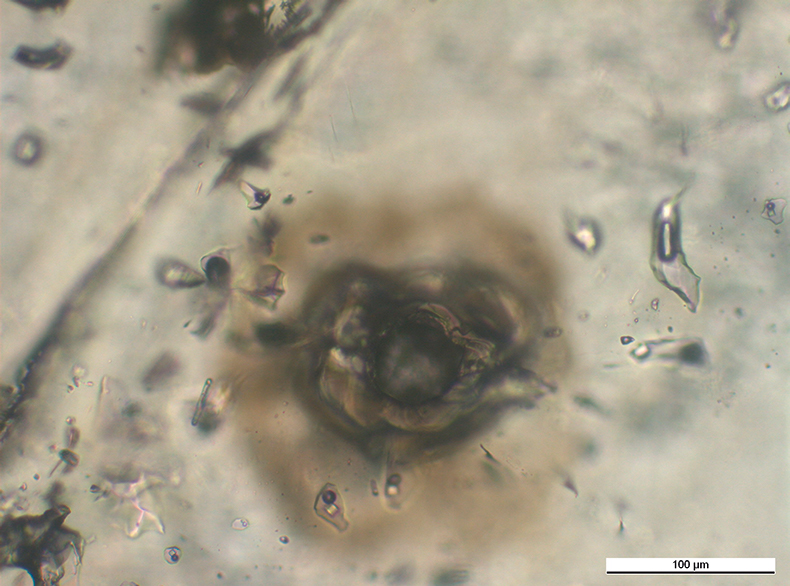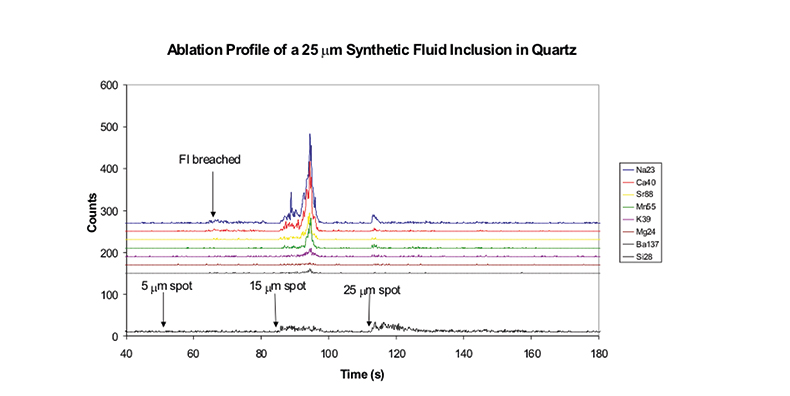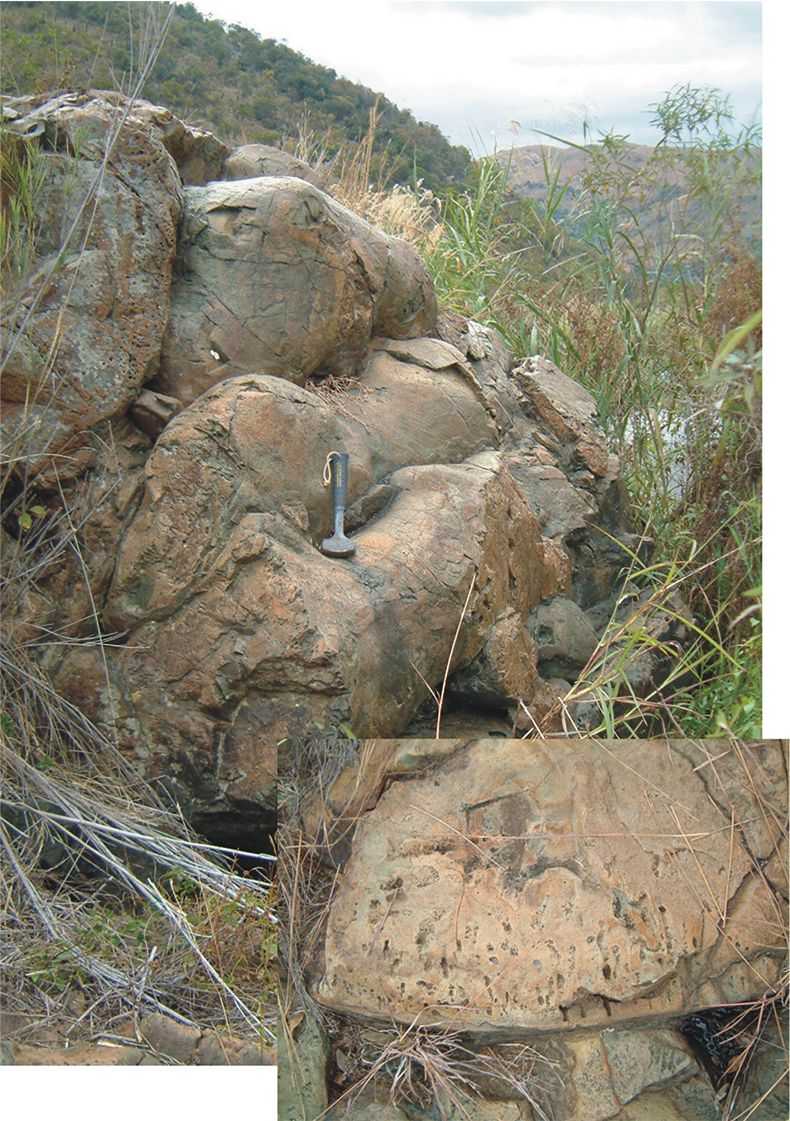Bruce Yardley and David Banks
School of Earth and Environment, University of Leeds, Leeds LS2 9JT, UK
Introduction
The whole natural cycle of our planet depends on processes going on beneath our feet, which create magmas, move tectonic plates, raise mountains and drive the continual recycling of rock materials. That this happens at all reflects the presence of water deep in the Earth’s crust.
While dry rocks are extremely strong and inert up to temperatures close to melting, the presence of even small amounts of water allows them to deform and flow, and permits minerals to dissolve and precipitate, which in turn concentrates metals into ore bodies. Such deep fluids are beyond the reach of sampling by drilling, and in any case, earth scientists are often interested in investigating what happened many millions of years ago, early in the Earth’s history. They are, however, preserved as tantalisingly small fluid inclusions (mostly ranging from < 2 µm to c. 20 µm across) in the minerals that grew from them.
The scientific study of fluid inclusions goes back to the middle of the 19th century, when Henry Clifton Sorby, a pioneer of using a microscope to study rocks, recognised that many of the granites and other crystalline rocks he was studying contained small bubbles of water in their quartz crystals, mostly with a small vapour bubble and, in some cases, salt crystals. Geochemists have sought for years to find techniques that would allow them to analyse the contents of these small liquid bubbles, but the challenge is formidable. The inclusions are very small indeed; it is often obvious from their appearance and behaviour when frozen that not all the fluid inclusions in a sample have the same composition, so crushing up a large mineral sample to extract all the fluid may give a meaningless mixture, and they are inevitably hosted by a mineral that will contaminate, and may dominate, any analysis. After the progressive development of techniques that yielded results for optimal samples, Laser Ablation Inductively Coupled Plasma Mass Spectrometry (LA-ICP-MS) has at last provided a means of analysing individual fluid inclusions in typical, rather than exceptional, samples. (Figure 1).

Figure 1. Magmatic fluid inclusions in quartz from Cerro Rico de Potosi, Bolivia. This is the site of the world’s largest silver deposit which has produced more than 2 billion ounces of silver since 1544 and was exploited by the Conquistadors. The figure shows a range of fluid inclusions with a central vapour bubble. A few high salinity inclusions have precipitated a salt crystal on cooling, which appears as a white square shape. In the centre is the crater remaining from the ablation of a single fluid inclusion—other inclusions nearby are unaffected.
The first truly quantitative LA-ICP-MS analyses of single fluid inclusions were carried out in ETH Zurich in a group led by Christoph Heinrich and Detlef Gunther. They addressed the key issues of ablating into transparent host crystals to release fluid in a controlled manner, minimising interferences and finding suitable calibration strategies, while at the same time quantifying a signal that is typically released over a time of just a few seconds, giving a brief surge in the signal but no definite plateau. The laboratory we have built up in Leeds is based on theirs, but we have significantly developed the data handling.
Experimental
Using the right laser system is the key to successfully analysing these small inclusions. For most purposes we study fluid inclusions hosted by quartz. It is transparent, allowing us to investigate the inclusions under the microscope and freeze them to discover the approximate concentration of salts, and it is generally sufficiently pure that it does not yield a significant background of any of the elements likely to be of interest in the fluid. Unfortunately, it is also transparent to most lasers, so we use a 193 nm excimer laser. We also need excellent optics to be able to select individual inclusions whose freezing behaviour has been investigated, and this is also provided by the Geolas Q Plus Laser Ablation system (Microlas). We are able to select individual inclusions just a few microns in diameter and continue to observe them as we ablate through the host crystal until they rupture.
Ablation takes place in a cell flushed by helium carrier gas. The gas supply is controlled by an Agilent 7500c ICP-MS, and the carrier gas is mixed with argon in a cyclone mixer before entering the plasma. The size of signal peak obtained from a small inclusion is of course maximised if the signal passes through the ICP-MS as quickly as possible, but unfortunately this has the effect of greatly reducing the precision of the analyses, because each mass is only counted a very few times before the signal has passed. Hence the volume of the ablation cell and the cyclone mixer has been chosen to give reasonable precision even though some small signals are not detected as a result (Figure 2).

Figure 2. ICP-MS signal from ablation of a synthetic fluid inclusion, c. 25 µm in diameter. In this example, the inclusion was first breached using a very small (5 µm) laser spot, but there was no significant signal until it was fully opened with a 15 µm laser spot. This ablation removed the bulk of the contents, although the signal is irregular, and further ablation with a 25 µm spot removed a small amount of additional salts.
The ICP-MS data is processed using a Matlab code, SILLS (Signal Integration for Laboratory Laser Systems), originally developed in Leeds by Murray Allan and subsequently refined at ETH Zurich.2 This allows signals from individual inclusions to be picked on the screen and combined with appropriate background segments. Because of its abundance in natural fluids, Na is used as the internal standard against which the concentrations of other elements are ratioed. This is not an ideal choice as the reproducibility of Na signals is not as good as for many other elements, but the element is so universal that there is no practical alternative. Calibration of these ratios is against NIST610 glass, but to obtain absolute concentrations we must use the salinity estimated from the freezing behaviour of the inclusion before it was ablated. We have made extensive investigations of the accuracy and precision of analyses made in this way, using synthetic inclusions of known composition,3 and while the results are clearly much less precise than most analysts are used to reporting, they are still of enormous value for understanding such an unknown field as the chemistry of ancient deep Earth fluids.
Results and discussion
Once you have the capability to analyse a 20 µm bubble of water inside a quartz crystal that could be half as old as the Earth, what to do? One of the most exciting applications of this technique is analysing remnants of the Earth’s earliest oceans from the time when life was just starting to evolve. Water is believed to have existed on the Earth at least 4000 million years ago, but it is impossible to find examples of such early seawater, as minerals and rocks formed under the correct conditions to trap the fluid do not exist. The oldest rocks that appear to contain ancient seawater are some 3500 million years old, such as those from South Africa illustrated in Figure 3. The tube-like form of the lava shows that it was extruded from vents onto the seafloor of the early Earth, as still happens today. The hot lava interacted with the cold sea dissolving silica from the rocks and re-depositing it in the gaps between individual flows or in gas escape bubbles as seen in the inset. Where these rocks have been unmodified, retaining their original shape, we can be reasonably certain that the trapped fluid inclusions are remnants of early seawater. By examining the fluid inclusions in similar rocks (and rocks formed in other marine environments) it is possible to track the evolution of seawater through geological time. When life was first forming and evolving, the Earth was quite different to today. The atmosphere had little oxygen; the oceans were hotter, saltier and reducing. Extensive iron oxide deposits were formed in the oceans and are a major source of iron ore today. It known that surface conditions changed gradually until around 2000 million years ago when there was a dramatic rise in atmospheric oxygen levels (to close to those of today) and an accompanying change in ocean chemistry. Deposition of iron largely ceased and there was a significant increase in the biota, largely photosynthetic algae. Understanding how the composition of the oceans changed is fundamental to understanding the evolution of life on our planet.
Another important application is in understanding how and why major metal ore bodies form. Many such deposits formed by precipitation of dissolved metals from solution. For example, an important class of copper deposits is associated with volcanoes, while many major lead and zinc ores formed from brines in sedimentary basins. Since similar ore bodies have formed in a similar way in different places and times, an understanding of the reasons for ore formation is essential to develop a model-based approach to exploration for new resources. The metal-bearing fluid is obviously a key component for ore formation but was until recently one of the least understood. Over the past decade, Laser Ablation ICP-MS has been applied to determining the composition of metal-bearing ore fluids and has shown that the concentrations of metals are often much higher than was previously thought likely. For example copper is present at c. 10,000 ppm in the magmatic vapours responsible for some deposits while lead and zinc occur at 100’s to 1000’s of ppm in sedimentary basin brines.

Figure 3. Pillow lavas that formed part of the seafloor 3500 million years ago (Komatii Gorge, South Africa). The lava was extruded in tube-like structures (“pillows”) from volcanic vents on the seafloor as still happens today. The inset shows a detail of the pillow margin with radial gas bubbles infilled by quartz.
Conclusion
The ability to analyse individual fluid inclusions in minerals using Laser Ablation ICP-MS is revolutionising our understanding of fluid processes in the Earth’s crust. Fluids are beginning to look a little less diverse as common traits are found that have been repeated many times in Earth history, and as well as helping build new practical models for ore formation, for example, this is throwing new light on our understanding of how the planet works as a whole.
Acknowledgements
We are indebted to the NERC, who supported the establishment of the LA-ICP-MS lab in Leeds through a JIF award, and to Linda Forbes and Murray Allan for their work in establishing the facility and developing protocols and procedures.
References
- D. Günther, A. Audétat, R. Frischknecht and C.A. Heinrich, J. Anal. Atom. Spectrom. 13(4), 263–270 (1998).
- M. Guillong, D.L. Meier, M.M. Allan, C.A. Heinrich and B.W.D. Yardley, in Laser Ablation ICP-MS in the Earth Sciences: current practices and outstanding issues, Ed by P. Sylvester. Mineralogical Association of Canada Short Course Series v. 40, pp. 328–333 (2008).
- M.M. Allan, B.W.D. Yardley, L.J. Forbes, K.I. Shmulovich, D.A. Banks and T.J. Shepherd, Amer. Mineral. 90, 1767–1775 (2005).

